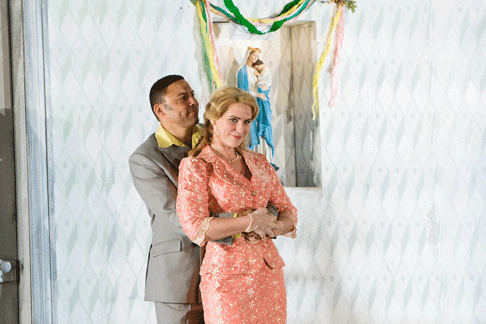One of the awards on that occasion was for Amanda Roocroft’s
assumption of the title role, and it was thus a luxury to have her back here
for the revival, heading a cast which was otherwise largely new. Clad neatly in
bright blue, this sunny golden-haired Jenůfa is, from the outset, a
contrast both with Charles Edwards’s Act 1 set, dominated by an ugly grey
workshop against a pale sky, and with the gaudy immodesty of
Števa’s hangers-on. Such is the impression made by her initial
good cheer that it is all too painful to follow the effect of the series of
personal tragedies that befall her. One would never think at the outset that
this was a girl who would end up getting married in a plain black dress
(against which her dead child’s red knitted cap is thrown into
particularly poignant relief).
Roocroft’s singing, too, is full of light at the outset, but by the
final curtain has given way to a measured, introverted luminosity. And in
between — well, after hearing of the death of baby Števuška
her voice is as drained and forlorn as the drab wallpaper in the
Kostelnička’s living-room. She had a strong partner in the
Norwegian conductor Elvind Gullberg Jensen — in his ENO debut — who
showed unfailing sensitivity in these moments of personal reflection, even if
he had a tendency to lose the shape of the music in the bigger, public
scenes.
Jenůfa’s initial sunniness presents just as sharp a contrast
with the Kostelnička, sung by the American mezzo Michaela Martens; though
her singing was powerful and at times gut-wrenchingly intense, barely a word of
the English translation (by Otakar Kraus and Edward Downes) was decipherable,
and her tone had a tendency to spread out at the height of the second-act
monologue. This production makes her rather severe; it is a shame we
didn’t see more of the internal struggle with her own human nature as the
realisation dawns that only she has the means to dispose of
Jenůfa’s ‘problem’.
Robert Brubaker’s Laca is quite outstanding, so alive with repressed
anger and frustration that he seldom even stands still. There was a wildness to
some of the louder moments which concerned me slightly at the time, but which
in hindsight I’m convinced must have been an intentional part of his
characterisation; in the final moments of Act 3, his passionate declaration of
love for Jenůfa was delivered in a full-blooded, secure, radiant
fortissimo — and with both feet firmly on the ground. Thomas Randle was
equally ideal as the irresponsible Števa, looking every inch the alpha
male, his bright, cocksure tenor making every note count.
 Tom Randle as Steva Buryja and Mairead Buicke as Karolka
Tom Randle as Steva Buryja and Mairead Buicke as Karolka
Iain Paterson (the only survivor other than Roocroft of the original 2006
run) was quite outstanding as the Foreman, every word delivered with precision
and sensitivity — and Susan Gorton made much of Grandma Buryjovka, her
wordless but telling reaction to the crass insensitivity of Karolka and family
supplying a rare but welcome moment of comic relief in Act 3.
David Alden’s staging has a few incongruous details; neither the
motorcycle on which Števa makes his first entrance, nor the
colourfully-clad village girls who dance for Jenufa prior to her wedding, seem
appropriate to the time and place. And the production bothered me more second
time around than it did when new. In the dreary surroundings of a small
industrial plant in the 1940s or thereabouts, the insistent staccato of the
opening orchestral theme is accompanied by flashes of light from welding tools
rather than the turning of a mill-wheel. The indoor setting of the second and
third acts is no more attractive, with slabs of old cardboard keeping out the
world in the place of closed shutters. Is the sadness, frustration and violence
in these people’s lives an inevitable result of miserable surroundings,
and not a product of their personal circumstances? It’s a valid
interpretation, if not one that makes for visually striking stage pictures.
Ruth Elleson © 2009

